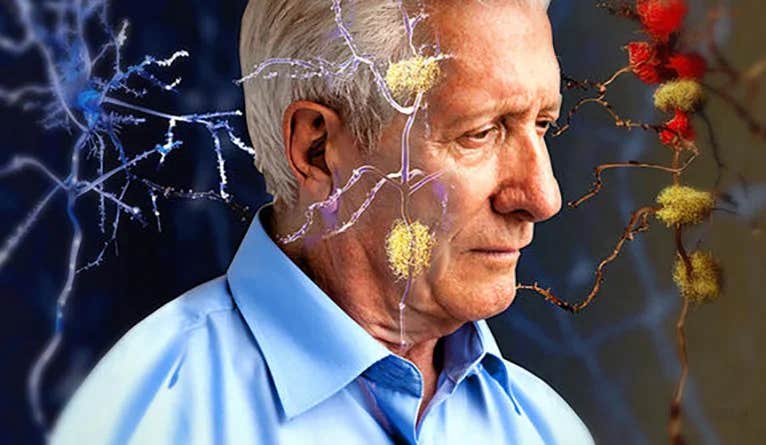Lifechanging study reveals the cause of Alzheimer’s disease and dementia
A groundbreaking study from OHSU has unveiled a new avenue of cell death in Alzheimer’s disease and vascular dementia

[Jan. 7, 2024: JJ Shavit, The Brighter Side of News]
Research has unveiled a new avenue of cell death in Alzheimer's disease and vascular dementia. (CREDIT: Creative Commons)
A groundbreaking study from Oregon Health & Science University (OHSU) has unveiled a new avenue of cell death in Alzheimer's disease and vascular dementia, offering a unique direction for future research and potential therapeutic interventions.
This seminal research, recently published online in the esteemed journal Annals of Neurology, reveals that a form of cell death known as ferroptosis, caused by an accumulation of iron within cells, is responsible for the obliteration of microglia cells in the brain.
Understanding Microglia and Their Role in the Brain
Microglia are the brain's resident immune cells. Ordinarily, these cells are actively engaged in clearing out cellular debris to maintain a healthy neural environment. They spring into action, especially when myelin, the protective sheath surrounding nerve fibers in the brain, becomes damaged. Their primary function is to eliminate the resulting debris.
However, this recent study has brought to light that the very act of clearing iron-rich myelin results in the destruction of the microglia themselves through ferroptosis. This discovery pivots our understanding of the progression of Alzheimer’s and vascular dementia.
Related Stories
Innovative Techniques Lead to New Insights
The OHSU research team, under the guidance of senior author and established neuroscientist, Stephen Back, M.D., Ph.D., delved into this study by examining post-mortem human brain tissue from dementia patients.
“This is a major finding,” emphasized Dr. Back, who has an extensive research background in myelin studies, especially concerning developmental delays in premature infants. The current findings, he says, takes this research further by revealing the interplay between neurodegeneration and myelin deterioration.
The innovative technique that made this discovery possible was spearheaded by the study’s lead author, Philip Adeniyi, Ph.D., a postdoctoral researcher in Dr. Back’s laboratory. This cutting-edge method brought into sharp focus the role of microglia in the white matter regions of Alzheimer's and vascular dementia patients' brains.
Stephen Back, M.D., Ph.D., a neuroscientist and professor of pediatrics in the OHSU School of Medicine, left, and Philip Adeniyi, Ph.D., a postdoctoral researcher in Back’s laboratory. The researchers discovered that microglia degenerates in the white matter of the brain of patients with Alzheimer’s and vascular dementia. (CREDIT: OHSU/Christine Torres Hicks)
Dr. Back, reflecting on the significance of these findings, remarked, “We’ve missed a major form of cell death in Alzheimer’s disease and vascular dementia. It’s just amazing that we missed this until now.”
Implications and the Way Forward
It's a revelation that's set to transform the way we perceive Alzheimer’s and vascular dementia. Co-author Kiera Degener-O’Brien, M.D., was the first to notice microglial degeneration in tissue samples. Building on this, Adeniyi's immunofluorescence technique confirmed that it was iron toxicity from myelin fragments leading to this degeneration. In essence, these immune cells were succumbing while performing their protective functions.
Microglial development, repopulation, and aging. Microglia progenitors are originated from the yolk sac and migrate to the brain parenchyma through the head neuroepithelial layer. (CREDIT: Frontiers in Aging Neuroscience)
Dr. Back highlighted the previously underestimated role of microglia, saying, “Everyone knows that microglia are activated to mediate inflammation. But no one knew that they were dying in such large numbers.”
These findings have broad implications. The progressive decline of microglia may very well be a driving mechanism behind the cognitive deterioration seen in Alzheimer’s and vascular dementia patients. Recognizing this, Dr. Back anticipates a surge of interest from the pharmaceutical industry.
Heterogeneity of microglia in the white matter. Heterogeneity in white matter microglia is present from the early stages of development, as microglia states in the developing CNS show gene enrichment related to phagocytosis and proliferation. (CREDIT: ResearchGate)
“That’s where the field will go next,” he asserted, hopeful about the development of compounds targeting microglial degeneration.
The starting point of this degenerative cycle likely roots back to repeated episodes of reduced blood flow and diminished oxygen supply to the brain. Factors such as acute stroke or chronic conditions, including hypertension and diabetes, might be contributing culprits.
Degenerative microglial (DM) phagocytose myelin debris. A typical Iba1+ DM (red) with a paucity of shrunken processes. Myelin debris (MBPd; green), visualized by staining for myelin basic protein (MBP), was extensively co-localized in the DM soma (merged; arrowheads), as confirmed in the orthogonal views. Scale bars = 20 μm. (CREDIT: Annals of Neurology)
Dr. Back concluded with a profound thought, “Dementia is a process that goes on for years and years. We have to tackle this from the early days to have an impact so that it doesn’t spin out of control.”
As we stand on the cusp of this breakthrough, the field of dementia research has received a renewed impetus. This discovery, encapsulating the pivotal role of ferroptosis, presents an untapped reservoir of opportunities for scientists, researchers, and pharmaceutical pioneers. Only time will tell how this newfound knowledge shapes the future of dementia care and therapeutics.
Note: Materials provided above by The Brighter Side of News. Content may be edited for style and length.
Like these kind of feel good stories? Get the Brighter Side of News' newsletter.
Joseph Shavit
Head Science News Writer | Communicating Innovation & Discovery
Based in Los Angeles, Joseph Shavit is an accomplished science journalist, head science news writer and co-founder at The Brighter Side of News, where he translates cutting-edge discoveries into compelling stories for a broad audience. With a strong background spanning science, business, product management, media leadership, and entrepreneurship, Joseph brings a unique perspective to science communication. His expertise allows him to uncover the intersection of technological advancements and market potential, shedding light on how groundbreaking research evolves into transformative products and industries.



